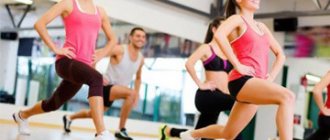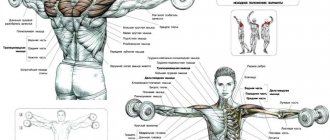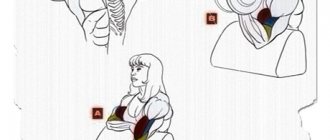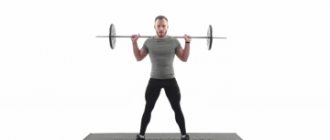Strength training without equipment
We are building a home workout that can replace going to the gym.
It doesn’t matter why you decided to work out at home - you’re just starting to train, for some reason you can’t go to the gym, or you go but don’t always have the opportunity, this article will be equally useful. So, for some reason the gym is inaccessible to us, and you don’t have any equipment at your disposal, not even a horizontal bar and parallel bars. Training under such conditions is considered less effective. Therefore, a beginner in such a situation postpones his start in sports for an indefinite period, and an already practicing athlete can simply skip training. And both will be wrong! Firstly, it is better to train at home than not to train at all.
. Beginners, by the way, are recommended to go to the gym having already achieved some results in exercises with their own weight, so that the body is ready for the load. And secondly, you can do a workout at home no worse than in the gym.
The basis.
Strength training involves performing a small number of repetitions, usually 4-12, but with a heavy load. Do 4 sets with this number of repetitions and that will be enough. If it's too easy, make it more difficult.
Squats.
Beginners.
Standard squats will be sufficient. There has long been a debate about whether to do full squats or lower yourself until your thighs are parallel to the floor, which is more dangerous and which is more effective. So, don't bother yourself with all this nonsense. When working with your own weight, full squats with maximum amplitude will be more effective and you will not be able to get injured. If you don't try hard enough.
Lovers.
For those who train in the gym, or for stronger beginners, you can double the load - squat on one leg. Having trouble keeping your balance? Hold on to the wall. Too hard? Help yourself with one hand, leaning into the chair. Too easy? Use a weighted backpack as additional weight and/or a couple of five-liter water bottles (you can fill them with sand instead of water). In general, a man's ingenuity will tell him.
Push ups.
Beginners.
Again, regular push-ups. You can diversify with narrow or wide positioning of the arms in order to engage different muscle groups. If you place your feet on an elevation so that the angle between the body and the floor reaches 45 degrees, the deltoid muscles will receive a good load. To put more stress on your triceps, you can add reverse chair push-ups:
Lovers.
Of course, we add weights. The same backpack will work great. Life hack: find a woman, put her on your back - do push-ups! You can also do push-ups with a clap - when rising, push off strongly, at the top point make a clap and land on slightly bent arms, repeat (the woman must be taken off before such an exercise).
Press.
One of the most effective abdominal exercises is the “bicycle”. Those who do not know what it is and how it is performed can watch this video:
How to train?
You can create a program for yourself from individual variations of these exercises and perform them sequentially. Or you can include them in circuit training
- this means that when you have completed a set of one exercise, you immediately start exercising another muscle group, then the third and repeat it all over again without a break. The advantage of such training is that you can experience a really serious load and, in addition to strength, you will also develop endurance.
Did you like the article? Like it
and click “
Subscribe to the channel
” so as not to miss new materials!
Source
Core workout
The core muscles are a set of muscles responsible for stabilizing the spine, pelvis and hips. This group includes not only the abdominal muscles, but also the muscles of the back, hips, buttocks and other muscles.
To train your core muscles, different variations of abdominal crunches are suitable. While the standard crunch is a good exercise, different variations will help you work more muscles.
Several variations of crunches require nothing more than your body (and maybe a mat or towel to perform comfortably). Let's look at some of them.
Slow crunches
Slow crunches are similar to regular abdominal exercises, but have a few differences. Firstly, they are performed much slower, which allows you to better work the abdominal muscles. Secondly, more attention is paid to breathing - it is important to correctly alternate inhalations and exhalations during execution.
Correct technique for performing the exercise:
- Lie on your back, stretch your arms along your body.
- Inhale and raise your arms in front of you.
- Exhale and slowly lift your body. The back should lift off the floor vertebra by vertebra, gradually twisting forward.
- When you reach a sitting position, continue moving your body forward towards your feet. At the same time, do not lower your arms, stretch forward, not down, do not straighten your back - it remains rounded. Breathe in.
- As you exhale, begin moving backwards. The back lowers to the floor as slowly as it rose.
- Lower your arms along your body.
Twisting Down
This exercise perfectly complements regular abdominal crunches.
Correct technique for performing the exercise:
- Lie on the floor, bend your legs at an angle of 45 degrees, feet flat on the floor.
- To get into the starting position, place your hands on your hips and lift your body, maintaining yourself in a sitting position.
- You can keep your hands on your hips throughout the exercise, but if you want to work your abs better, extend them out in front of you.
- In the starting position, inhale, then exhale and slowly lower your back towards the floor.
- Lower yourself until your shoulder blades touch the surface. Do not lower your back too low - your body should remain suspended at all times.
- Inhale, and then exhale, return to the starting position. At the extreme point, the back is slightly rounded.
You can try different numbers of approaches, but you should not do more than 15 repetitions at a time.
A hundred
This is a difficult exercise, so it's okay if you don't succeed the first time.
Correct technique for performing the exercise:
- Lie on your back, bend your knees at an angle of 45 degrees, place your feet on the floor. Hands lie on the floor, palms down. The back does not press against the floor, but does not arch either.
- Lower your chin slightly and begin to lift yourself up, tensing your abs. When you have reached the desired position, lift your arms off the floor and extend them forward on either side of your body.
- In some variations of the exercise, the legs are raised so that the shins are kept parallel to the floor and the angle at the knee is 90 degrees. If this is too difficult for you, you can do the exercise without lifting your legs.
- Keeping your arms extended, begin to quickly move them up and down with a small amplitude. The up and down movement is counted at one time.
- Alternate inhalation and exhalation every five times. For example, you inhale on the first rep, then on the tenth, then the twentieth, and exhale on the fifteenth, twenty-fifth, and so on.
- Do the exercise 100 times. If you can't do 100 reps right away, rest on the fiftieth and then continue.
Main bar
This is a simple exercise that works your entire core. It may take practice to master the plank position, but once you find the right position, it's just a matter of holding it.
Correct technique for performing the exercise:
- Lie on your stomach, elbows close to your body, palms on the floor.
- Tighten your abs and slowly lift your torso off the floor, engaging your abs, glutes, and legs.
- Avoid arching your lower back or raising your hips high, and do not strain your neck.
- Continue breathing while holding your body in a plank position for 15 seconds.
- The goal for beginners is three sets of 6-12 reps.
Other core exercises
Once you've mastered these exercises, you'll likely want to add variety to your workouts. Here are more core workouts, a 20-minute Tabata workout to target your abs, back, and glutes, and exercises to help runners develop their core muscles.
A set of static exercises without special equipment
A set of static exercises involves a set of poses that have a comprehensive and diverse effect on our body.
Static poses are excellent as general developmental fitness, in which the muscles get good tone, endurance and coordination of movements develop.
There are many “subsections” of statics, which few people think about as statics. This includes yoga, Pilates, isometric gymnastics, and other systems of physical development.
Static exercises easily and organically fit into the training of athletes involved in various sports. Dancers also cannot do without static.
It is difficult to find more accessible exercises that are easily integrated into a complete and self-sufficient system of sports activities. The number of static poses is diverse and cannot be quantified. It’s enough just to stand straight and try to “reach” the top of your head to the ceiling - and you’ve already done a static exercise.
On topic: Biology test practice
We present to your attention a set of static exercises without special equipment, which will load most muscles and gently stimulate the cardiovascular system to work. It can be used during morning exercises, as a warm-up before running and before fitness classes.











